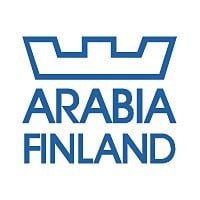In 1873 the Finnish factory Arabia started off with the manufacture of porcelain and earthenware on a plot of land carrying the same name on the northern outskirts of Helsinki. Being a subsidiary of the Swedish ceramics factory Rörstrand, it was up to Arabia to serve the Russian market in a period of boom. After the successful World Fair, which was held in Paris in 1900, a period of economic decline began and demand from Russia and North America for porcelain and earthenware from Finland started to slacken off. At the end of WW I, Arabia was passed into Finnish hands and a period of prosperity began. In 1929, the factory took over parent company Rörstrand. After the economic depression in 1932, demand for earthenware and porcelain collapsed and the company started to pioneer by automatising the production process and improving efficiency.
During WW II the factory had expanded enormously and employed some 2,000 workers. Kaj Franck was hired in 1945 who designed and introduced the 'Kilta' range in the early 50s, a leading example of the modernisation process, involving new concepts relating to kitchen ware that a household might need. This took Arabia into the realm of modern communication and advisory work which included educating the public, consultation and press services. In addition to the Kilta range, other new products came on the market including 'AR-Heini' (Kaarina Aho/Raija Uosikkinen, 1957) and 'Liekki' by Ulla Procopé (1958).
A new production material, stoneware, was introduced into Arabia’s household range. The first tableware set made from the new material was Ulla Procopé’s Ruska, well-known worldwide. The much-loved Paratiisi series by Birger Kaipiainen was launched in 1969.
The oil crisis and the problems caused by cheap imports led to cut-backs in personnel and the product range. They were also the reason for a three-year period (1975-1977) of collaboration in marketing between Arabia and Rörstrand. The production of annual plates with a Kalevala theme by Raija Uosikkinen was launched in 1976. New lines in tableware included 'M-Karelia' (Anja Jaatinen-Winquist 1970), 'EH-Faenza' (Peter Winquist 1973), 'Tea for Two' (Gunvor Olin-Grönqvist 1978) and 'Arctica' (Inkeri Leivo 1979). The latter being the first set of tableware to emerge from the tunnel kilns that was made from a new material, vitro porcelain.
Kaj Franck modernised his Kilta series, which was relaunched under the name 'Teema' in 1981. Other novelties included 'Tuuli' (Heljä Liukko-Sundström 1983), 'Saaristo' (Inkeri Leivo 1985), 'Microset' (Göran Bäck 1986), 'Teema' (Kaj Franck 1987), 'Domino' (Kati Tuominen/Pekka Paikkari 1987) and 'Harlekin' (Inkeri Leivo 1989).
Arabia's owner company Wärtsilä acquired Rörstrand in 1984, and six years later, Arabia was taken over by Hackman.
In 2000, the company name changed into Iittala, followed by a take-over by the Fiskars Group in 2007. Arabia, however, remains to be Finland's most valued and well-known brand to this day.







